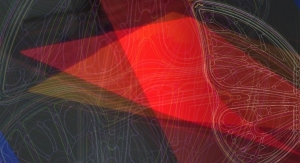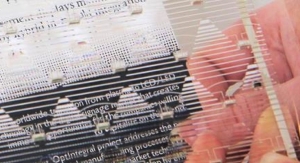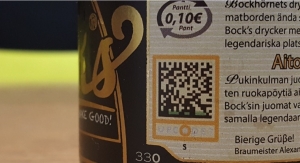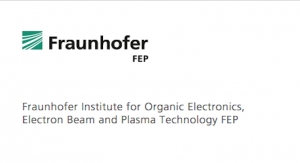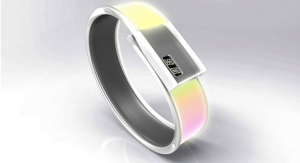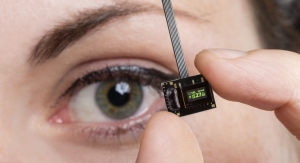04.04.18
Fraunhofer Institute for Organic Electronics, Electron Beam and Plasma Technology presents its first wearable OLED bracelet at Wearables Europe 2018, from April 11-12 in Berlin, Germany together with VTT Technical Research Centre of Finland and Holst Centre from The Netherlands.
Organic light emitting diodes (OLED) as novel and elegant or stylish light source have already found their way to the common furniture stores and can be purchased as pendants from the shelf. At the same time OLED is already on the agenda of light and product designers in the automotive industry. However they are not merely famous for their comfortable luminous color or their wide range of possibilities in the design of shape, color and size. The research focus in the field of medical applications and light therapy is more and more taking OLED into account for various scenarios. The goal is to be able to create OLED light sources that emit the light in special wave lengths to use OLED for wound healing or for therapy for depression.
Since 2016, partners within the European joint project PI-SCALE are working on the introduction of a joint pilot line in order to give access for the manufacturing of flexible OLED for SMEs in Europe. At Wearables Europe 2018, Holst Centre, VTT Technical Research Centre of Finland and Fraunhofer FEP will introduce a novel OLED wristband. This bracelet is representing one of the first wearable products with flexible organic electronics from the European pilot line.
Fraunhofer FEP was responsible for the anode deposition on barrier web, which has been produced by the Holst Centre as well as for the OLED-deposition by using evaporation processes. The OLED-deposition at Fraunhofer FEP can be done in Roll-to-Roll (R2R) and Sheet-to-Sheet (S2S) processes.
VTT integrated the ready-made OLED into a bracelet and developed the compact power supply for the whole system. The successful integration of the flexible OLED components into 3D injection molded structures was challenging.
“We used injection molded structural electronics for the integration of the OLED,” VTT’s Markus Tuomikoski reported. “To meet the demands of a wearable device, the conception and realization of a compact power supply system was necessary. In the end we realized a combination of flexible electronics and flexible OLED within our plastic molded bracelet uncomplicated thanks to the positive joint work of the partners.”
VTT’s hybrid integration line is constructed with commercially available manufacturing equipment, making it possible to adapt the developed process for industrial use fast without the need to develop totally new production machinery or process control systems. Injection molding of electronics with thermoplastics enables cost-efficient, fully integrated and seamless manufacturing of highly functional 3D structures that are ideal for e.g. the fast-growing wearables and healthcare product markets.
The lightweight bracelet with flexible OLED can be used as fashion jewelry and lighting for several days due to the low power consumption of the OLED. Equipped with red or yellow OLED, the wristband could act as security device for people working at night-time outside or in dark environment.
The OLED could also be realized emitting light in a special wavelength. Using this advantage, such a bracelet could help for wound healing while wearing it on hands or legs. Using the positive effect of the warm OLED light, it is useful e.g. for the therapy for depression.
The partners of the Pi-Scale consortium are still available for interested partners and customers after the project time of Pi-Scale. Under the name of LYTEUS, the activities of the pilot line service and the realization of concrete products will be pushed further on in future.

Source: Fraunhofer FEP
Organic light emitting diodes (OLED) as novel and elegant or stylish light source have already found their way to the common furniture stores and can be purchased as pendants from the shelf. At the same time OLED is already on the agenda of light and product designers in the automotive industry. However they are not merely famous for their comfortable luminous color or their wide range of possibilities in the design of shape, color and size. The research focus in the field of medical applications and light therapy is more and more taking OLED into account for various scenarios. The goal is to be able to create OLED light sources that emit the light in special wave lengths to use OLED for wound healing or for therapy for depression.
Since 2016, partners within the European joint project PI-SCALE are working on the introduction of a joint pilot line in order to give access for the manufacturing of flexible OLED for SMEs in Europe. At Wearables Europe 2018, Holst Centre, VTT Technical Research Centre of Finland and Fraunhofer FEP will introduce a novel OLED wristband. This bracelet is representing one of the first wearable products with flexible organic electronics from the European pilot line.
Fraunhofer FEP was responsible for the anode deposition on barrier web, which has been produced by the Holst Centre as well as for the OLED-deposition by using evaporation processes. The OLED-deposition at Fraunhofer FEP can be done in Roll-to-Roll (R2R) and Sheet-to-Sheet (S2S) processes.
VTT integrated the ready-made OLED into a bracelet and developed the compact power supply for the whole system. The successful integration of the flexible OLED components into 3D injection molded structures was challenging.
“We used injection molded structural electronics for the integration of the OLED,” VTT’s Markus Tuomikoski reported. “To meet the demands of a wearable device, the conception and realization of a compact power supply system was necessary. In the end we realized a combination of flexible electronics and flexible OLED within our plastic molded bracelet uncomplicated thanks to the positive joint work of the partners.”
VTT’s hybrid integration line is constructed with commercially available manufacturing equipment, making it possible to adapt the developed process for industrial use fast without the need to develop totally new production machinery or process control systems. Injection molding of electronics with thermoplastics enables cost-efficient, fully integrated and seamless manufacturing of highly functional 3D structures that are ideal for e.g. the fast-growing wearables and healthcare product markets.
The lightweight bracelet with flexible OLED can be used as fashion jewelry and lighting for several days due to the low power consumption of the OLED. Equipped with red or yellow OLED, the wristband could act as security device for people working at night-time outside or in dark environment.
The OLED could also be realized emitting light in a special wavelength. Using this advantage, such a bracelet could help for wound healing while wearing it on hands or legs. Using the positive effect of the warm OLED light, it is useful e.g. for the therapy for depression.
The partners of the Pi-Scale consortium are still available for interested partners and customers after the project time of Pi-Scale. Under the name of LYTEUS, the activities of the pilot line service and the realization of concrete products will be pushed further on in future.

Source: Fraunhofer FEP





